EDITOR’S NOTE: Please be advised that this Chiang Rai travel guide hasn’t been updated in 2025. Prices and travel guidelines may no longer be accurate so it’s important that you verify any information before proceeding.
The first time I heard about Chiang Mai was over twenty years ago. I was in Bangkok with a buddy of mine and we were on our way down south, to Koh Samui. Fresh out of college, we were stoners at the time so it didn’t take us long to find weed in Bangkok. We bought a small packet from a tuk-tuk driver and he was the one who told us about Chiang Mai up north. He described how opium was abundant in the region and that the Golden Triangle was one of the largest opium-producing areas in the world. Being a pair of potheads, we were intrigued.
That stoner trip to the Golden Triangle never came to fruition but it did get me interested in the area. Through the years, I learned that Chiang Mai was synonymous with elephants, digital nomads, and the similarly named city of Chiang Rai. Rarely did I read about Chiang Mai without Chiang Rai being mentioned with it. In my mind, it became a given that you couldn’t visit one without the other. You had to do both.
It may have been twenty years in the making, but my trip to Northern Thailand finally happened in 2017 when we decided to attend the Yee Peng Festival in Chiang Mai. Chiang Rai was our first stop.
Save This on Pinterest!
No time to read this now? Click on the red save button and pin it for later!
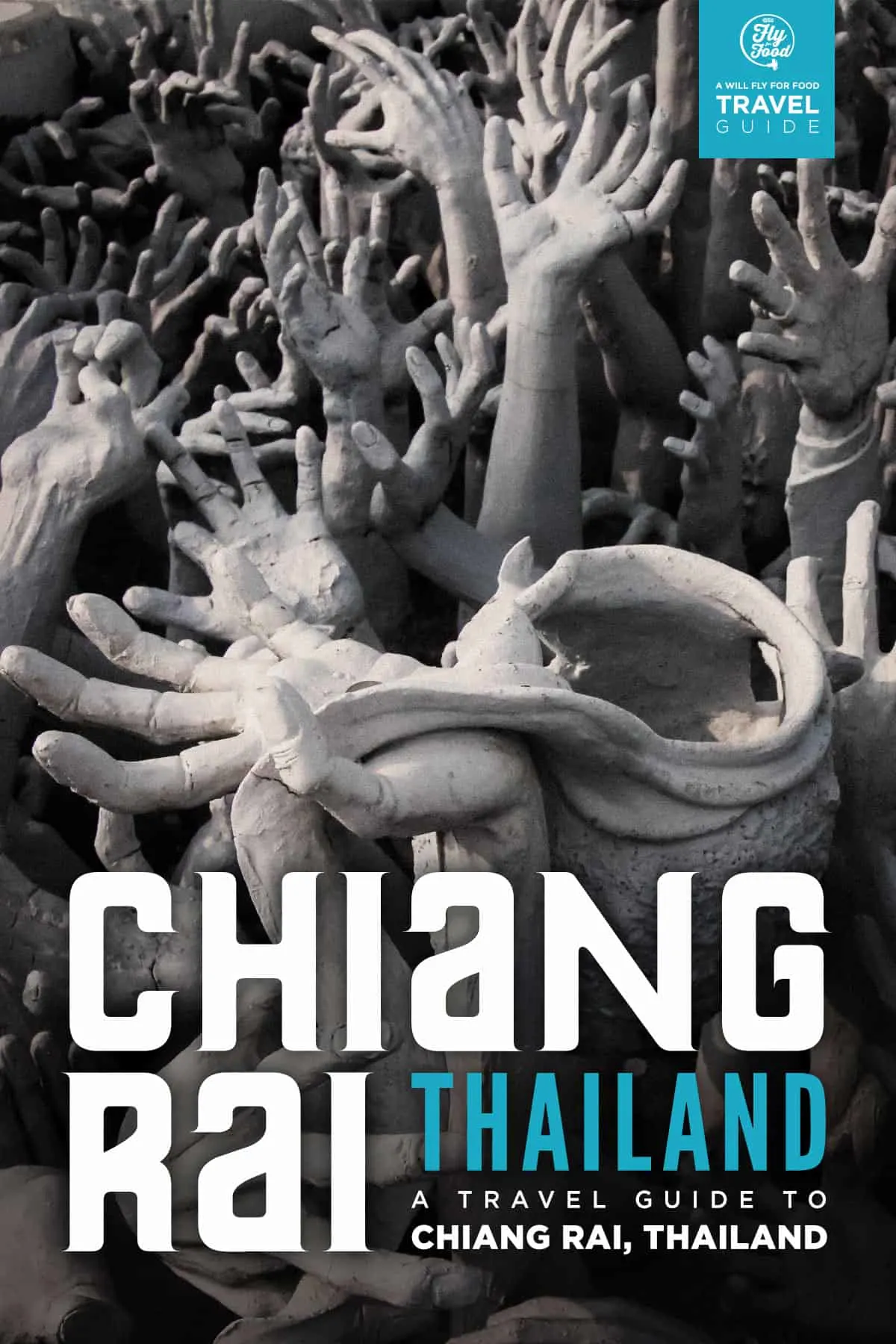
GUIDE TABLE OF CONTENTS
TRAVEL RESTRICTIONS
Because of the current global situation, travel guidelines seem to change on a weekly basis. Our friends at SafetyWing created a website that lists detailed information on travel restrictions around the globe.
Before doing any serious planning, be sure to check the Flatten the Curve website for information on travel restrictions to Thailand.
WHAT’S IN CHIANG RAI?
Chiang Rai is regarded as the northernmost “large city” in Thailand, though it isn’t actually that big. It’s much smaller and less developed as a tourist destination than neighboring Chiang Mai. It’s perhaps best known for Wat Rong Khun, a striking all-white temple located about 14 km south of the city. The ornate structure serves as both a Buddhist temple and an art exhibition, its most distinguishing characteristic being an ocean of sculpted hands reaching out from either side of a bridge. So unique and spectacular is the White Temple that many tourists make the 3-hour trip from Chiang Mai just to see it.
BEST TIME TO VISIT CHIANG RAI
Chiang Rai is three hours north of Chiang Mai by bus. Weather-wise, November to February is the best time to visit the region. It’s the coolest and driest time of the year. We were there in early November to attend the Yee Peng and Loy Krathong Festivals in Chiang Mai. Celebrated annually on the full moon of the twelfth lunar month, it’s a famous event and one of the most festive times to be in the region.
NOV-FEB: Like any Southeast Asian city, it can get hot and humid in Chiang Rai so shoot for November to February for the most comfortable weather. Daytime temperatures hover around 25°C (77°F) with few rainy days. As described, the Yee Peng Festival happens in November every year so you may want to plan your trip around that. That’s what we did. If you enjoy flowers, then you may want to go in February to attend the Chiang Mai Flower Festival.
MAR-MAY: March to May is the hottest time to be in Chiang Rai with temperatures often reaching 40°C (104°F). It isn’t the most comfortable time to visit, but Songkran or the Thai New Year is celebrated every April. The Songkran Festival in Chiang Mai turns the city into a big water fight making it a fun time to visit.
JUN-OCT: This is the monsoon season in Northern Thailand and probably not the best time to visit the region.
Climate: Annual Monthly Weather in Chiang Rai
Follow the link for more on Chiang Rai’s weather. For your convenience, I’ve created average temperature and annual rainfall graphs below. Suggested months to visit are colored in orange.
Average Temperature
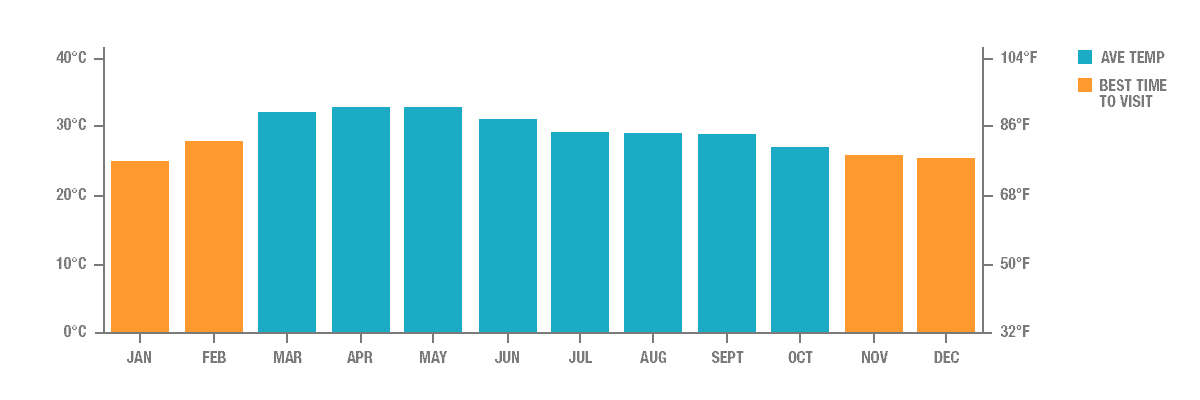
Annual Rainfall
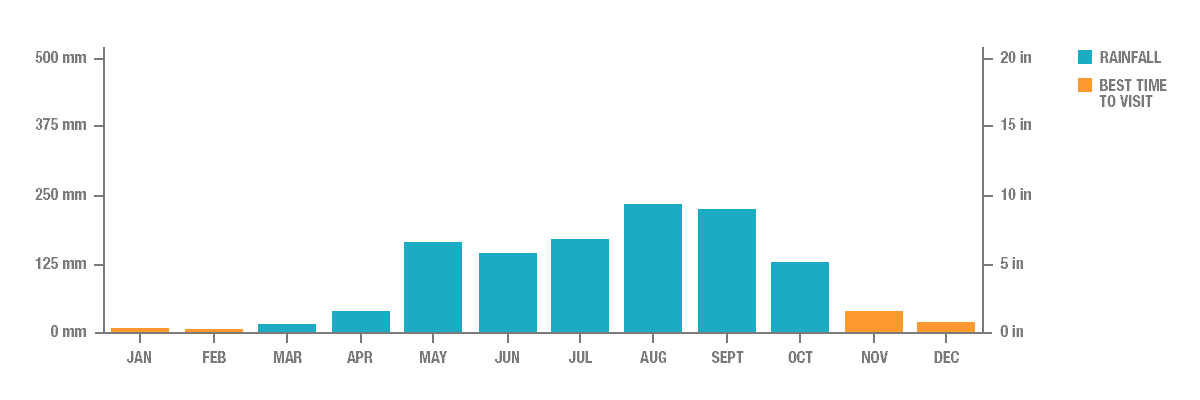
TRAVELING TO CHIANG RAI
We flew in to Chiang Rai from Bangkok, but the majority of tourists will probably travel by bus from Chiang Mai. It’s just three hours away so it’s even possible to do it on a day tour.
From Chiang Mai
BY BUS: Traveling by bus or minivan from Chiang Mai is one of the most popular ways of getting to Chiang Rai. The trip takes a little over 3 hours and you can book tickets on Bookaway.
BY PRIVATE TRANSFER: It’ll be more expensive but you can also book a private transfer from Chiang Mai to Chiang Rai through Bookaway.
BY DAY TOUR: If you’re interested in seeing the must-visit attractions in Chiang Rai but don’t want to spend the night, then you can do so on a guided day tour from Chiang Mai. These Chiang Rai day tours (option 1 | option 2) take you to key attractions like Wat Rong Khun (White Temple), Baan Dam Museum (Black House), and Wat Rong Sear Tean (Blue Temple).
From Bangkok
BY AIR: Our trip revolved around the 2017 Yee Peng Festival so we decided to visit Chiang Rai first before proceeding to Chiang Mai. We flew in from Bangkok via AirAsia for a little over THB 1,280 each with a 20 kg shared baggage allowance. The flight takes around 1 hour and 15 minutes.
Once you arrive at Chiang Rai International Airport (CEI), exit through the left and look for the metered taxi stand pictured below. Give them your hotel’s name to be assigned a taxi. It should cost you around THB 120-150 to get to downtown Chiang Rai.
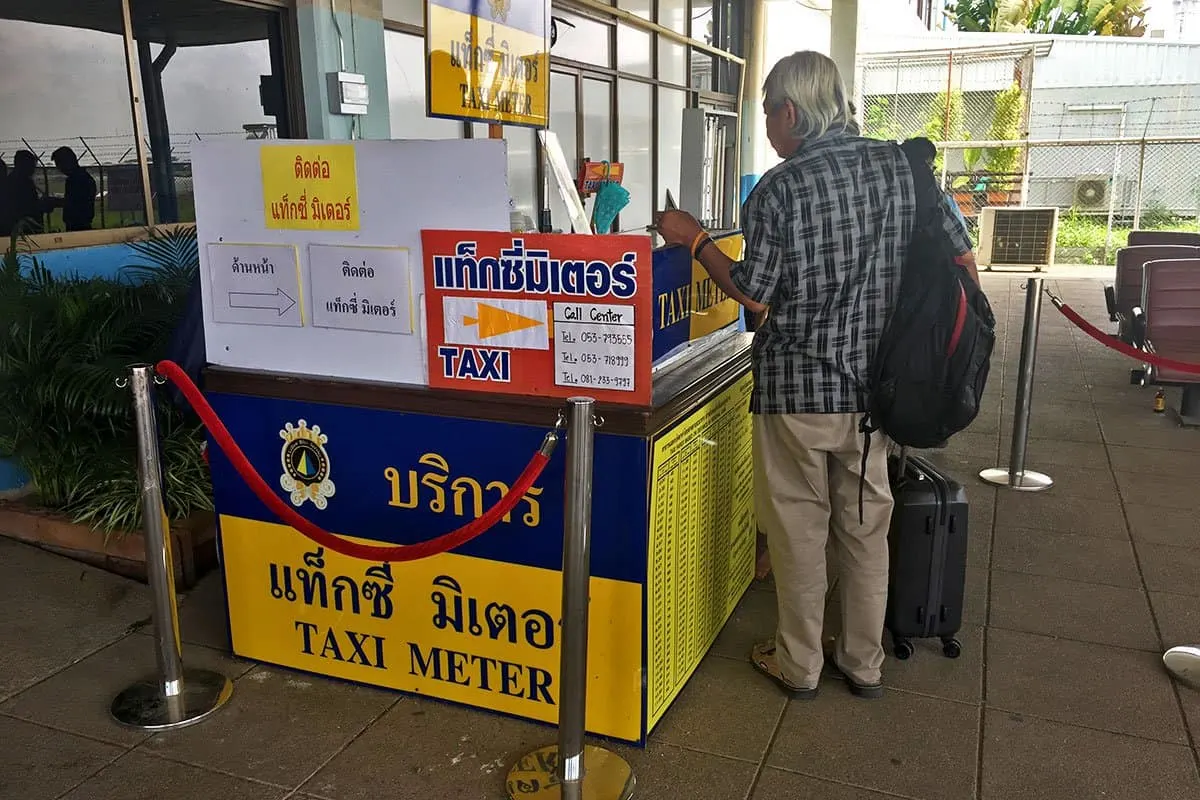
BY BUS: It’ll take much longer but you can also travel by bus from Bangkok to Chiang Rai. The trip will take at least 13 hours and you can book tickets on Bookaway.
From Other Cities
The methods above outline the most common means of getting to Chiang Rai, but there may be other ways of getting there depending on where you are. I suggest checking Bookaway to find route options available to you. You can click on the link or use the widget below.
WHERE TO EXCHANGE CURRENCY
The unit of currency in Thailand is the Thai Baht (THB). SuperRich is considered by many to give the best exchange rates in Thailand. We exchanged our currency at a SuperRich in Bangkok and we did get outstanding rates.
However, there don’t seem to be any Super Rich branches in Chiang Rai. If you can’t exchange currency at a Super Rich in a bigger city like Bangkok or Chiang Mai, then your best bet in Chiang Rai would probably be a bank.
A better option in Chiang Rai may be to withdraw THB from an ATM. You’ll usually get good rates but just be sure to advise your bank you’ll be using your ATM card abroad so you don’t run into any problems. In my experience, my ATM card works in some machines but not in others. I didn’t have any problems with it in Thailand.
WHERE TO STAY IN CHIANG RAI: Chiang Rai Hotel
If you want a centrally located hotel, then I doubt you’ll find a more centrally located hotel than this one. Chiang Rai Hotel is a minute away from the Clock Tower and walking distance to the city’s points of interest like the Night Bazaar and the old bus station (Terminal 1). The hotel’s a little old but it’s cheap and the rooms are huge. There’s cable TV with a few English channels too.
You can book a room at Chiang Rai Hotel through Agoda. You can search for alternate listings in Chiang Rai through Booking.com or Agoda as well.
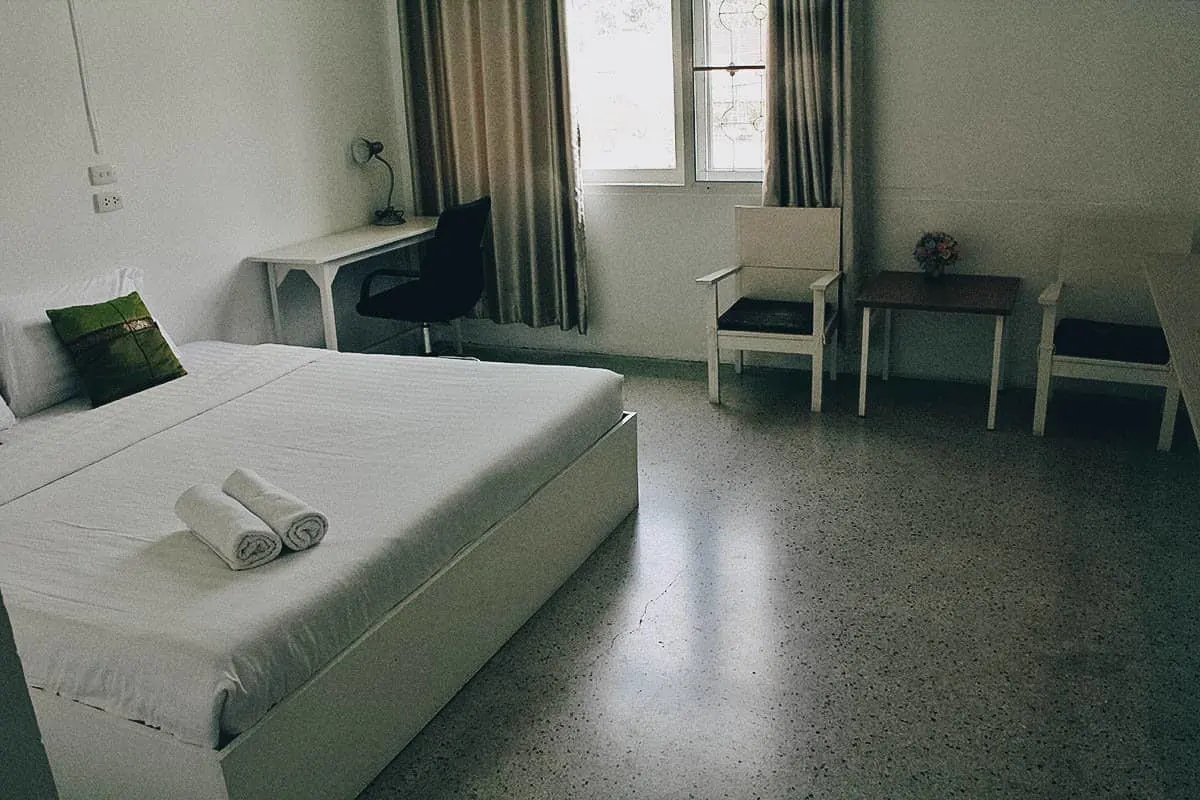
Approximate Room Rate: USD 24 per night (as of Jan 2018)
Down the street from the hotel is Chiang Rai’s famous Golden Clock Tower. Like I said, it doesn’t get more centrally located than this.
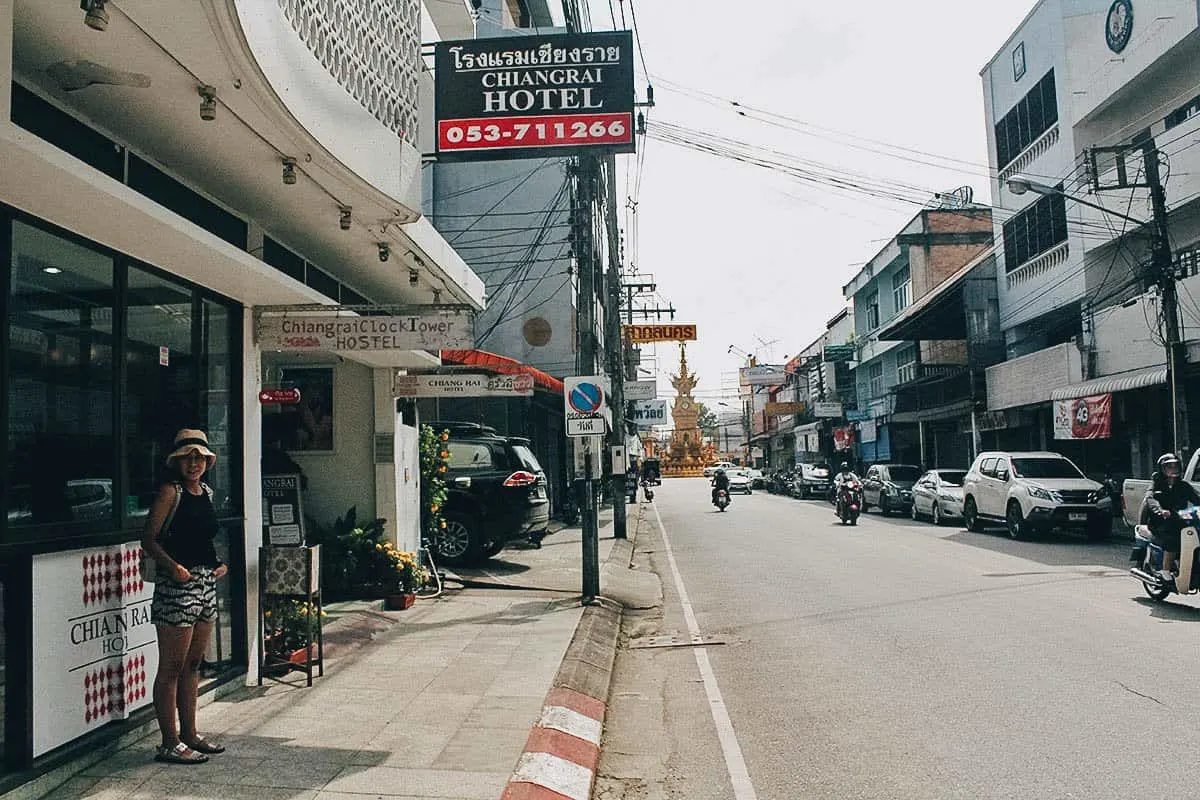
THINGS TO DO IN CHIANG RAI
1. Marvel at the Sight of Wat Rong Khun (White Temple)
Wat Rong Khun or the White Temple is far and away Chiang Rai’s premier attraction. I wouldn’t be surprised if many people make the trip from Chiang Mai specifically for this temple. We did.
A work-in-progress that was designed and created by local artist Chalermchai Kositpipat, the entire temple is almost entirely white with small mirrors attached to the plaster. This makes the temple look even brighter, like it’s glistening in the sun. It’s an incredible sight, one you won’t find anywhere else in Thailand. Check out my post on Wat Rong Khun for more pictures and information on how to arrange for a DIY day trip.
We visited on our own but you can go on a guided tour as well. You can book half-day or full-day tours through Klook. Either tour will take you to Wat Rong Khun and other key attractions in Chiang Rai.
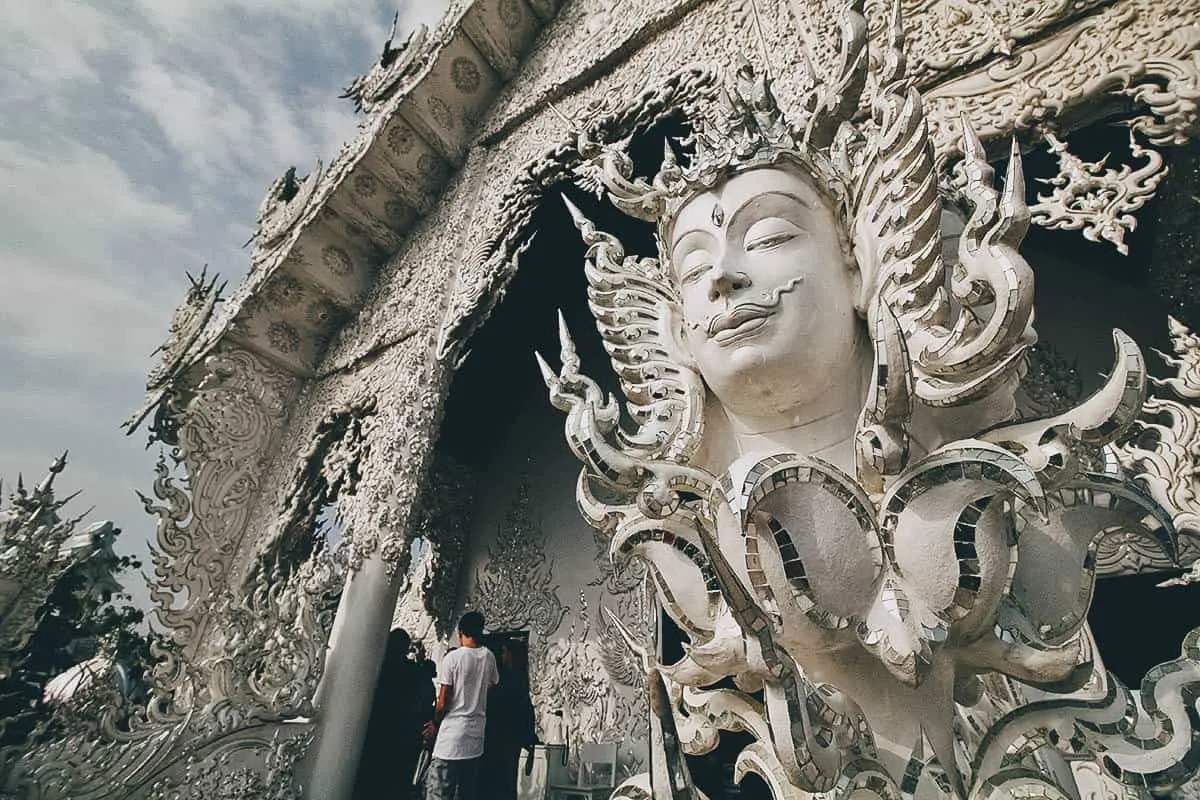
Estimated Time to Spend: Around 1-2 hours / Admission: THB 50
2. Visit the Home of a Thai National Artist at Baan Dam Museum (Black House)
Baan Dam Museum or Black House is the home and studio of the late Thawan Duchanee, a National Artist of Thailand famous for his paintings and architecture. It’s considered Duchanee’s architectural masterpiece and is comprised of a collection of about 40 buildings spread out over a landscaped garden. Located north of the city, you can visit Baan Dam Museum on the same day trip as Wat Rong Khun. Check out my post on Baan Dam Museum for more pictures and information on how to arrange for a DIY day trip.
Like the White Temple, we visited the Black House on our own but you can go on a guided tour as well. You can book half-day or full-day tours through Klook. These are the same tours that take you to Wat Rong Khun.
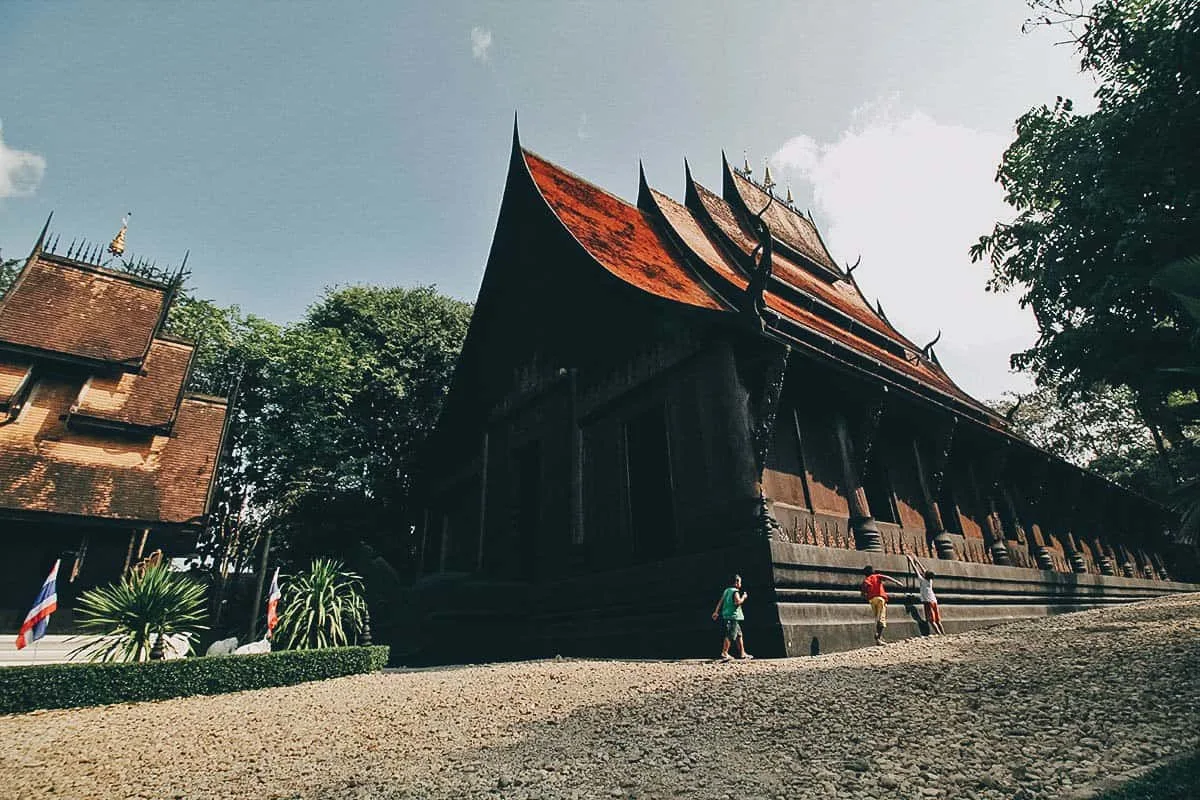
Estimated Time to Spend: 1-2 hours / Admission: THB 80
3. Enjoy the Uniqueness of Wat Rong Sear Tean (Blue Temple)
Like Wat Rong Khun, Wat Rong Sear Tean or the Blue Temple is probably one of the most unique temples in Chiang Rai. As its name suggests, its a predominantly blue temple bespeckled with ornate golden details. If Wat Rong Sear Tean reminds you of Wat Rong Khun, it’s because the Blue Temple was designed by one of Chalermchai Kositpipat’s students. Located just north of the Kok River, you can make a stop here on your way back to the city from Baan Dam Museum. Check out this post to find out how.
You can easily visit the Blue Temple on your own but if you’d rather go on a guided tour, then you can book half-day or full-day tours through Klook. These are the same tours that take you to Wat Rong Khun and Baan Dam Museum.
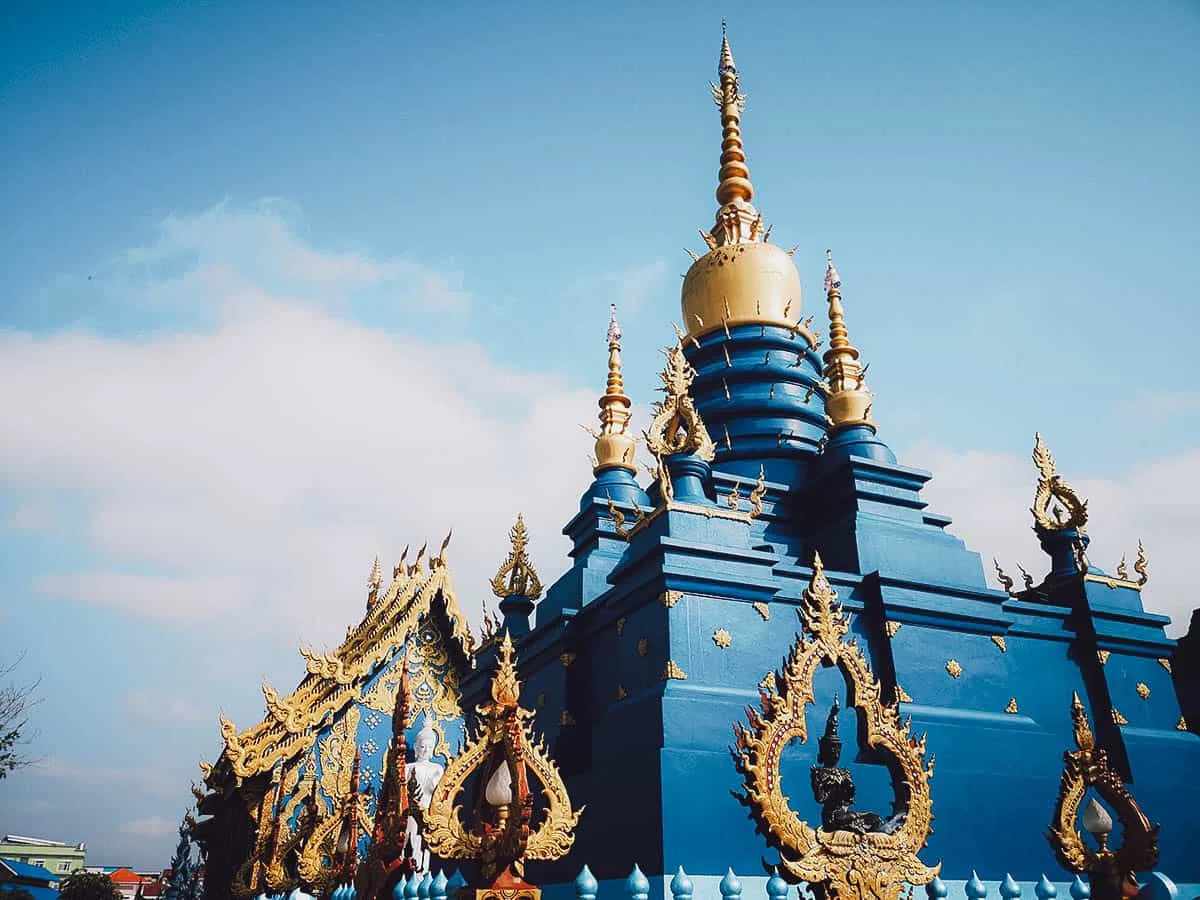
Estimated Time to Spend: 1 hr / Cost: FREE
Photo by Aphiwat Rodthuk via Shutterstock
4. Explore Chiang Rai City
Chiang Rai’s main attractions may lie beyond the city’s limits, but you’ll find a few points of interest within the city as well. There’s the Golden Clock Tower for one, and lesser known temples like Wat Phra Kaew, Wat Phra Sing, and Wat Klang Wiang are all worthy of a visit if you have the time.
If you’re staying in downtown Ching Rai, then you can easily walk to each of these places from your hotel. Check out this post on exploring Chiang Rai City for more pictures and information.
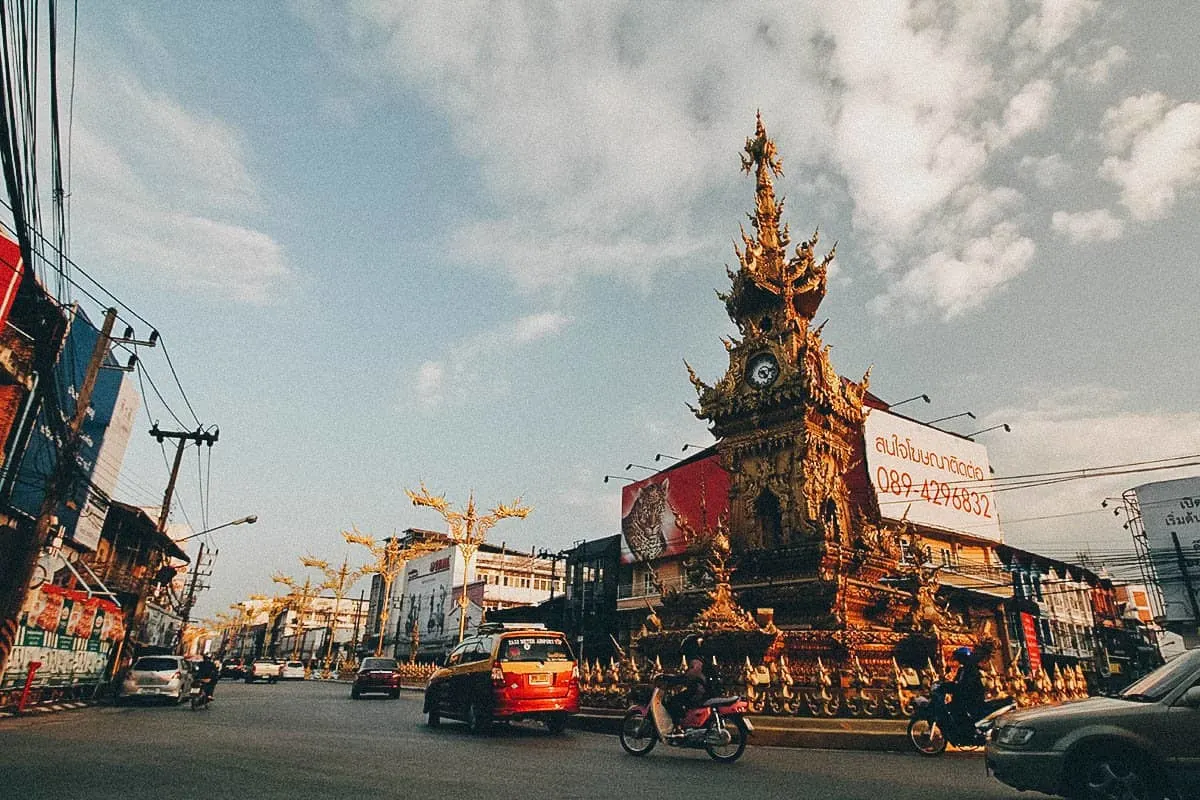
Estimated Time to Spend: Around 2-3 hours / Cost: FREE
5. Shop & Eat at Chiang Rai Night Bazaar
Once the sun has come down and you’ve had your fill of temples, then it’s time to head over to the Night Bazaar for some late night shopping and eating. Chiang Rai’s Night Bazaar is a small outdoor market offering the usual goods like hill tribe jewelry, elephant pants, and silk scarves, but what we enjoyed most about it was the food. More on that in the next section of this guide.
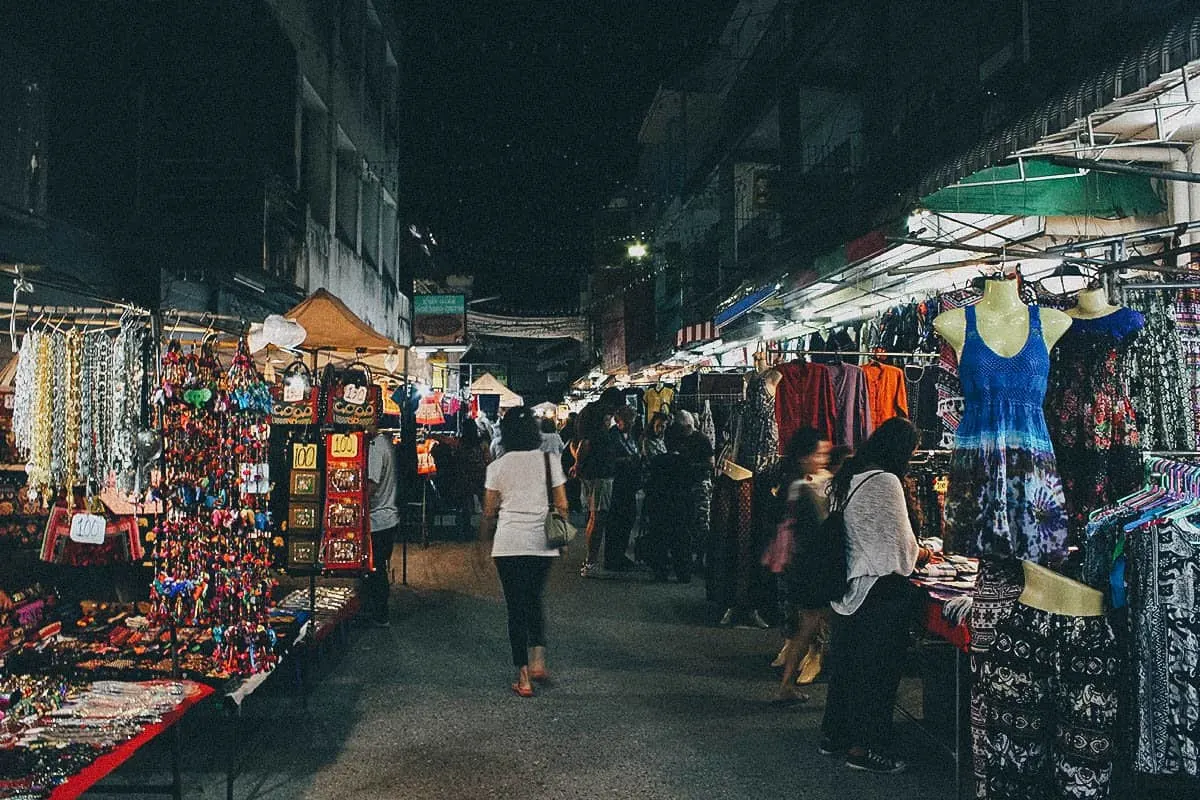
6. Take a Cooking Class
Ren’s a great cook so a cooking class is something we always try to make time for on a trip. So far, we’ve taken cooking classes in Bali, Phuket, Chiang Mai, Hoi An, and Marrakech. All have been excellent and have taught us a lot about the local cuisine. It’s one thing to taste unfamiliar food, but it’s quite another to look under the hood and learn what goes into making each dish.
Many tour providers offer cooking classes but Cookly is the only site I know of that focuses exclusively on cooking classes. They offer one-day cooking classes in many cities around the world, including Chiang Rai. Follow the link to check out Cookly’s list of cooking classes in Chiang Rai.
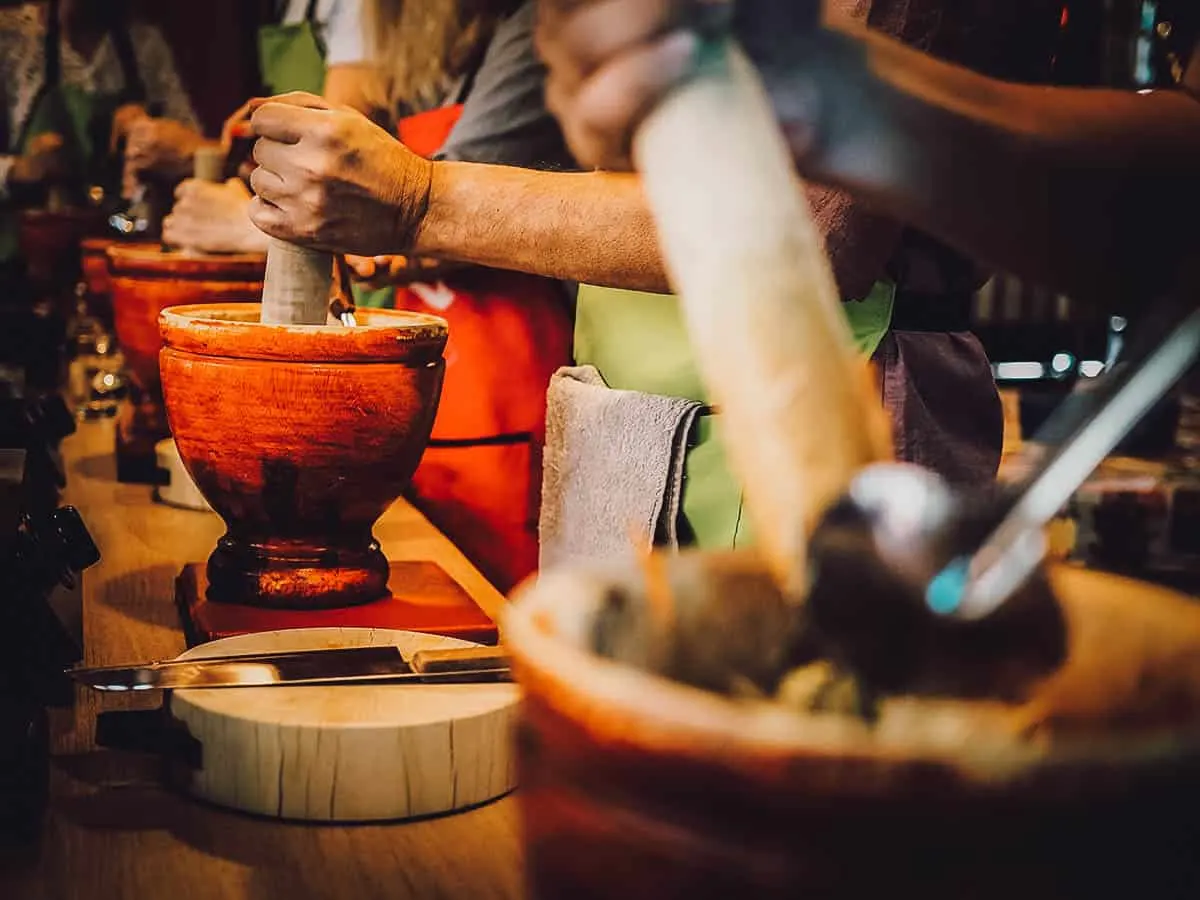
Photo by shellygraphy via Shutterstock
THAI FOOD GUIDE
Thailand is home to one of the greatest cuisines in the world. If you’d like to go beyond the usual pad thai, then be sure to check out our Thai food guide for a list of 45 must-try dishes in Thailand.
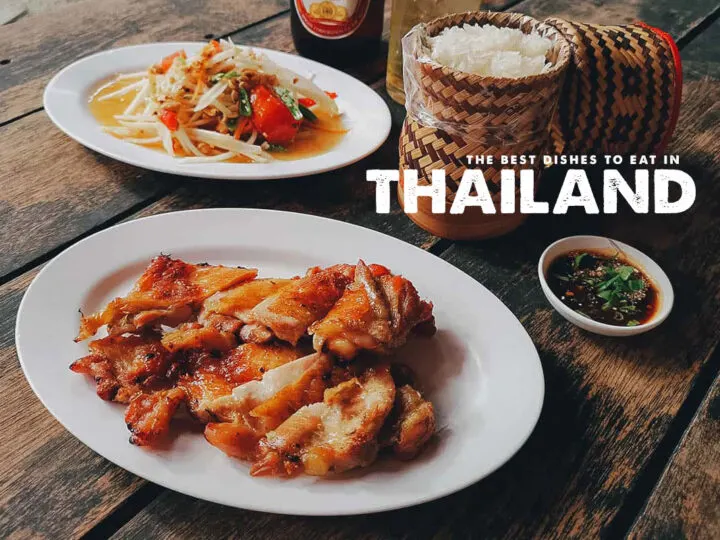
THAI DESSERTS
Savory Thai dishes are fantastic, but so are Thai desserts. Don’t miss out on these 25 traditional Thai desserts on your next visit to Chiang Rai.
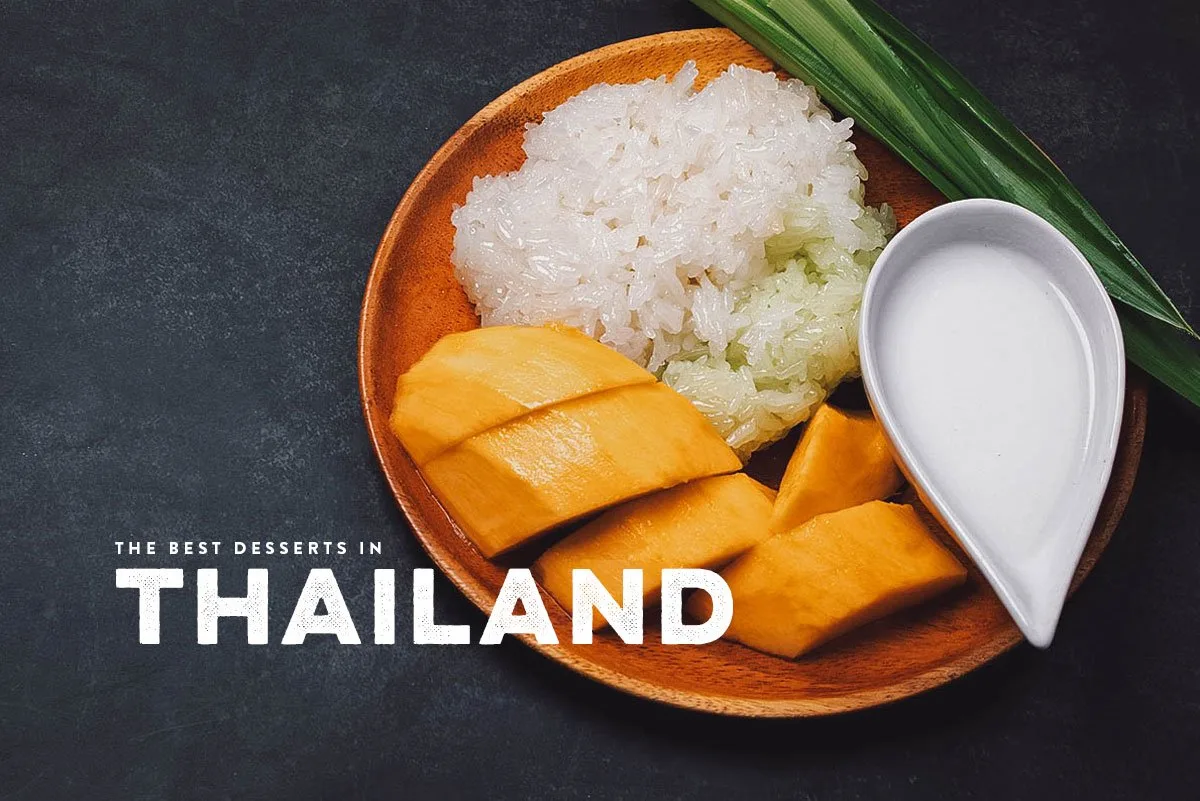
WHERE TO EAT IN CHIANG RAI
1. Khao Soi Phor Jai (Pho Chai)
Every trip to Chiang Rai or Chiang Mai should begin with a bowl of khao soi. It’s believed to be a Burmese-influenced dish consisting of crispy and soft egg noodles in a creamy, curry-like sauce made with coconut milk and meat, usually chicken or beef. It’s typically served with a side of chopped red onions, pickled cabbage, and a wedge of lime. If you were to have just one dish in Chiang Rai, then it should be khao soi. It’s the quintessential Northern Thai dish.
You’ll be spoilt for choice with all the restaurants serving khao soi in Chiang Rai, but Khao Soi Phor Jai is said to be one of the best. Aside from the usual chicken khao soi, they offer shrimp and fish khao soi as well, the latter being a more rare variety based on what I’ve read. We got the chicken and shrimp, both of which were supremely delicious, but you may want to get the fish if you want something different. We got ours with a packet of pork rinds for some extra crunch. Yum!
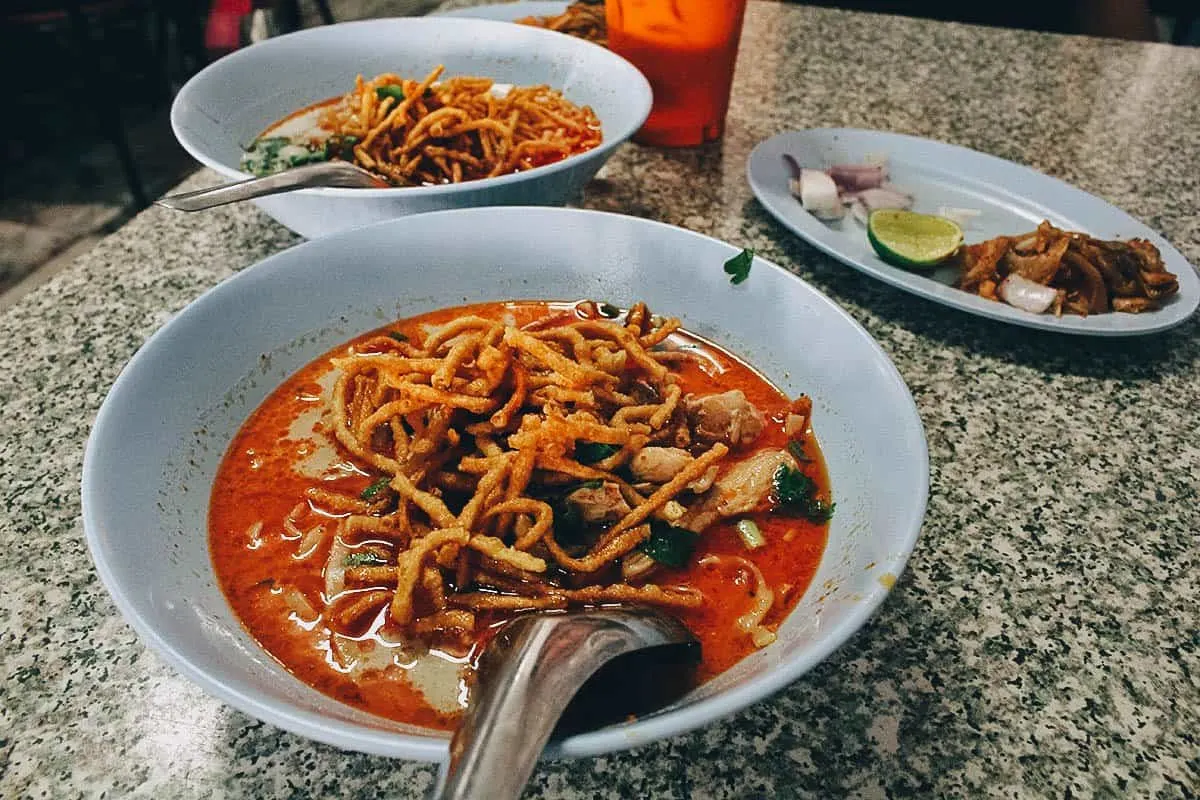
Khao Soi Phor Jai was packed with both locals and tourists when we were there. It’s just a short walk from the Clock Tower so it’s easy to get to on foot.
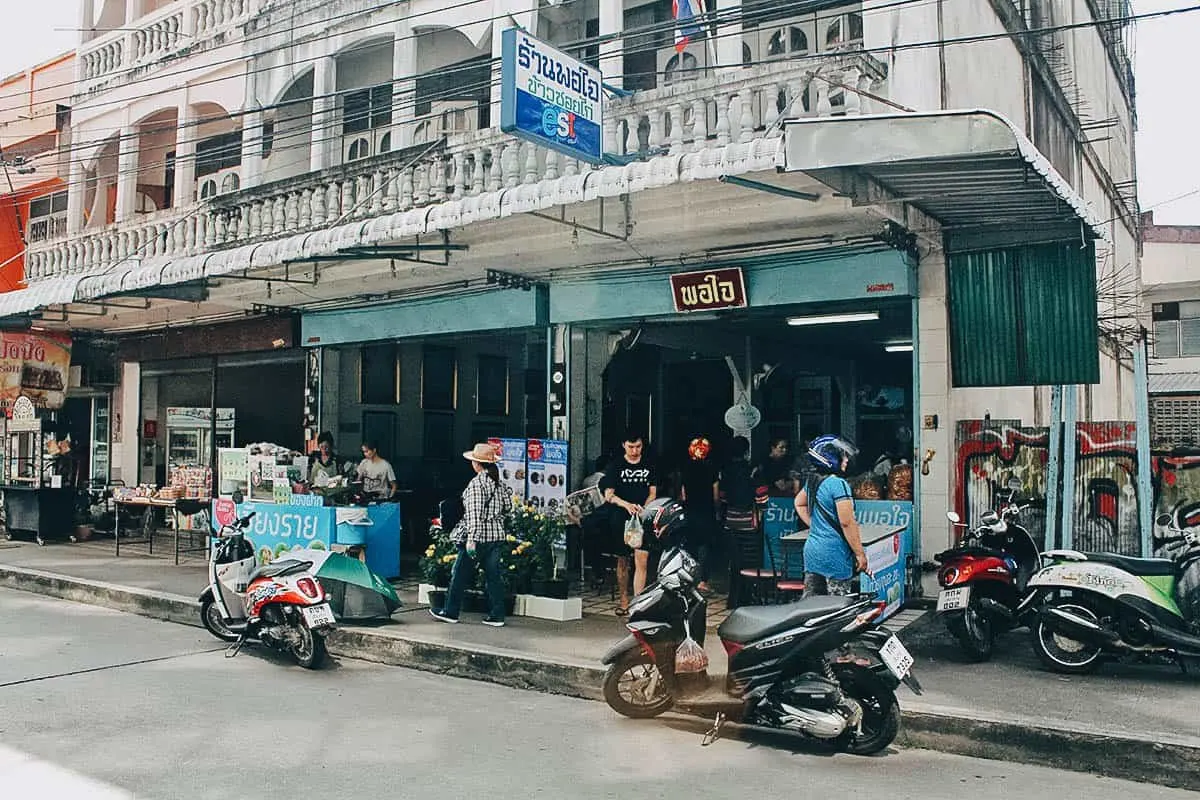
Estimated to Spend: THB 40 per bowl of khao soi
2. Ran Lab Sanam Keela
Ran Lab Sanam Keela is one of the most popular local restaurants in Chiang Rai. They’re known for serving authentic Lanna food. I learned about this restaurant from eatingthaifood.com and the one dish that jumped out at me was the pla tabtim tod kratiem. It’s a dish of deep-fried golden tilapia served under a mountain of garlic. How insanely beautiful does that look?
The garlic cloves were coated in a thin layer of batter while the fish was deep-fried to crispy perfection, so much so that you didn’t have to worry about any bones. You could just crunch your way through the whole fish! We had a few other dishes at Ran Lab Sanam Keela, which I’ll write about in a separate post soon, but this was definitely the highlight of our meal. It’s a big fish that can easily be shared by 2-3 people.
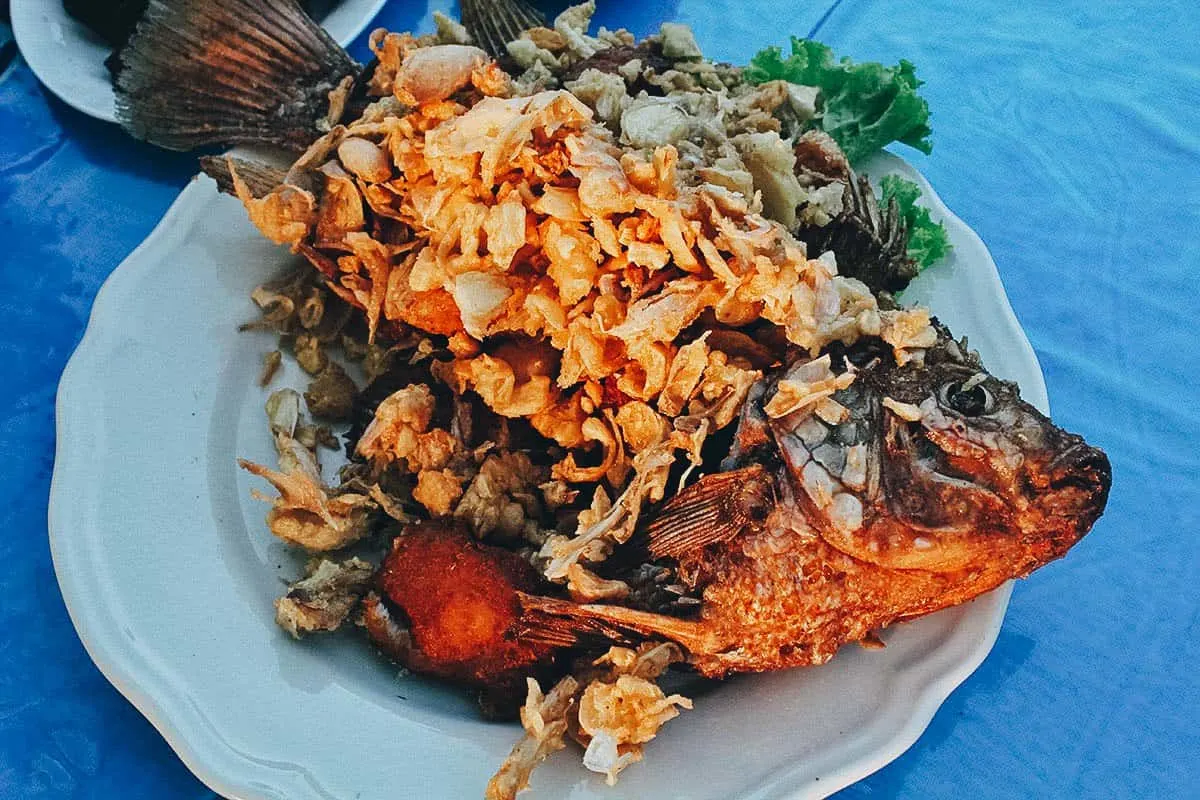
Ran Lab Sanam Keela is located on the outskirts of town so it may be too far to walk. You might want to take a tuk-tuk, taxi, or Uber. We took Uber and it cost us just a little over THB 56 each way from Chiang Rai Hotel.
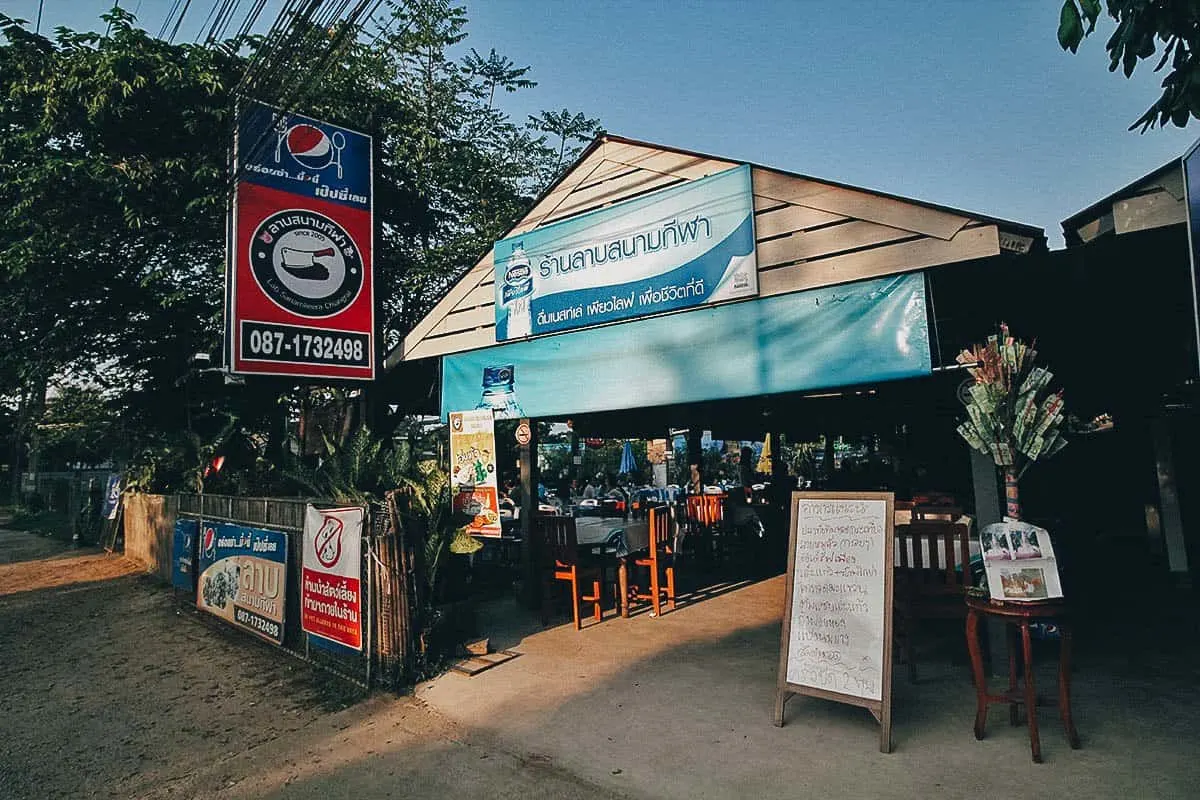
Estimated to Spend: THB 200 per order of pla tabtim tod kratiem
3. Lu Lam Restaurant
Like Ran Lab Sanam Keela, Lu Lam is another of Chiang Rai’s most popular local restaurants. It’s situated by the Kok River giving you pleasant views of the water. Lu Lam specializes in Northern Thai cuisine so it’s a great place to try staples like larb (minced pork), sai oua (Northern Thai sausage), and this nam prik ong (chili-based dip). We had nam prik ong (red chili) and nam prik noom (green chili) several times on this trip and the version at Lu Lam was excellent. For the most daring, I read on migrationology.com that Lu Lam is a good place to try lou, or raw pig’s blood soup. Yes, RAW pig’s blood soup.
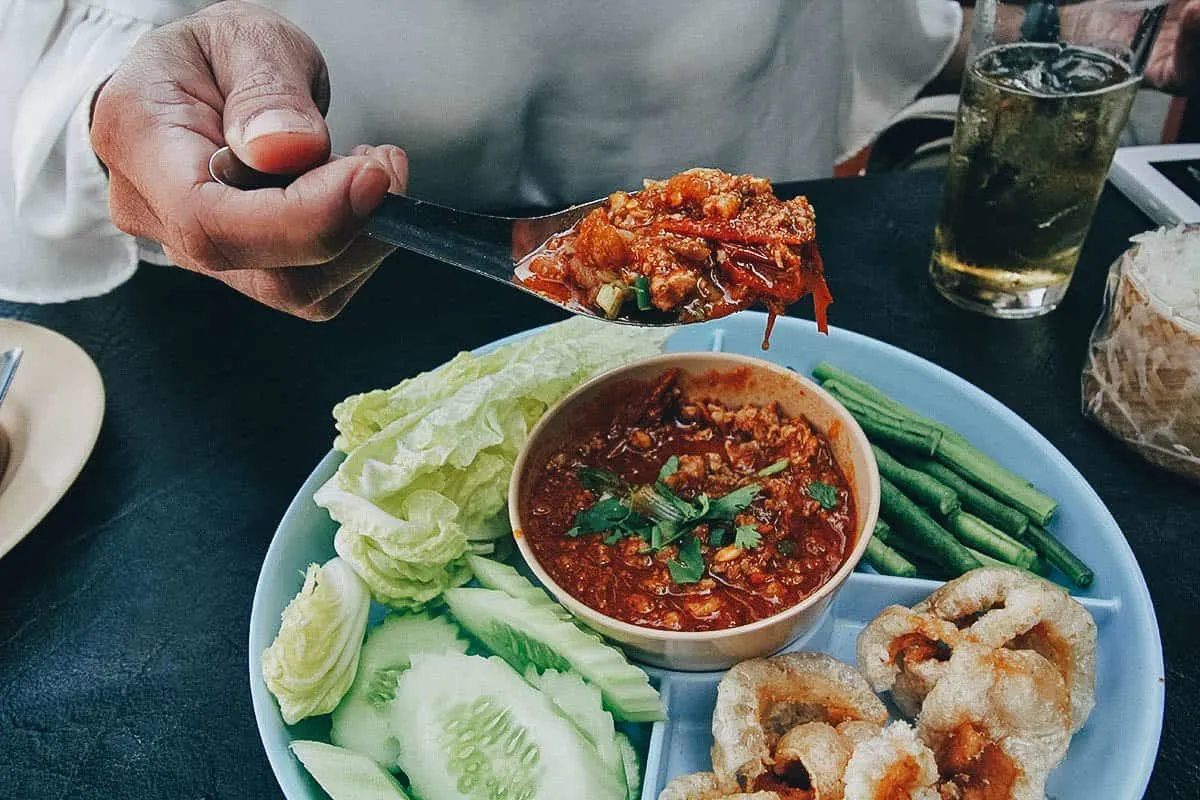
Like Ran Lab Sanam Keela, Lu Lam is located on the outskirts of town, right by the Kok River, so it may be best to go via taxi, tuk-tuk, or Uber. We had our tuk-tuk driver drop us off here for lunch after visiting Wat Rong Khun and Baan Dam Museum. We then took an Uber back to our hotel for less than THB 50.
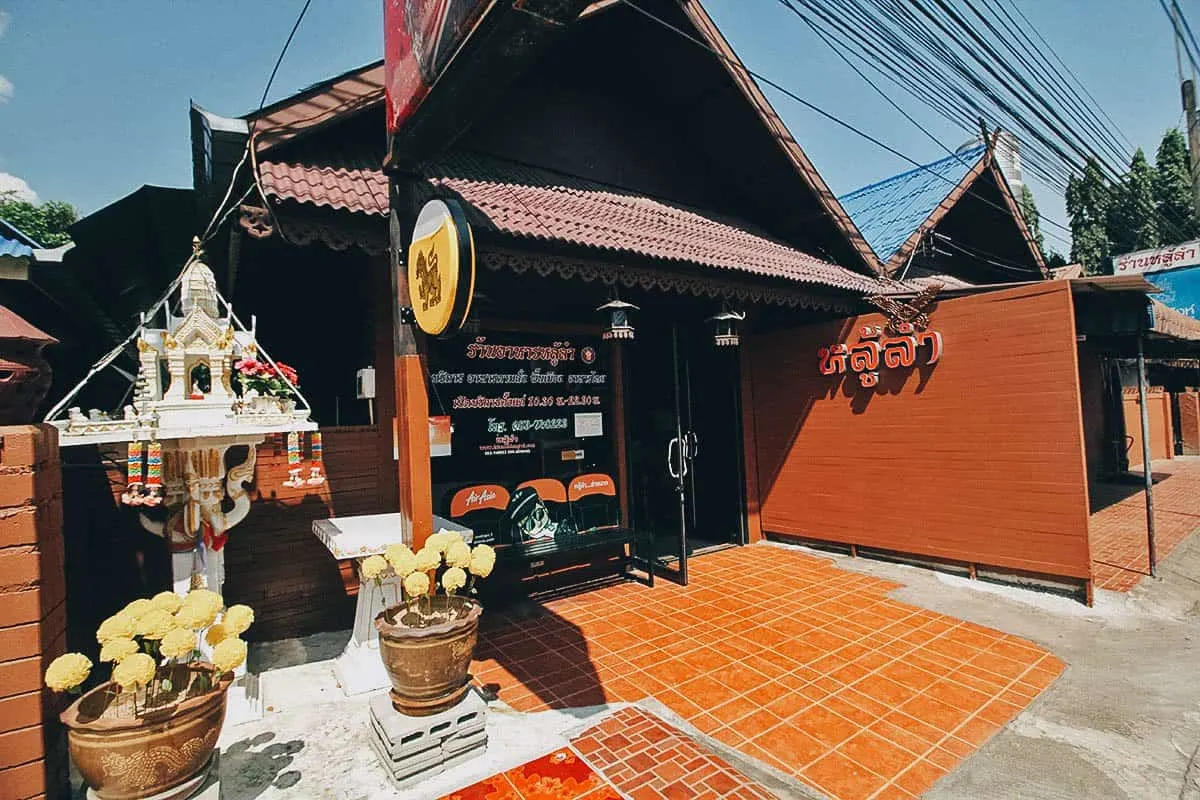
Estimated to Spend: Around THB 150 per person
4. Ja Jaroenchai
Ja Jaroenchai is a restaurant that specializes in Thai Chinese food. Like Ran Lab Sanam Keela and Lu Lam, I learned about this place from eatingthaifood.com. I read that some of their most famous dishes include pad makua sawuy, which is a dish of stir-fried eggplant with minced pork. We wanted to get the pad yod on tandawan moo krob as well, which is stir-fried sunflower sprouts with crispy pork belly, but they were out of the sprouts so they substituted it with bok choy instead. Both dishes were very tasty.
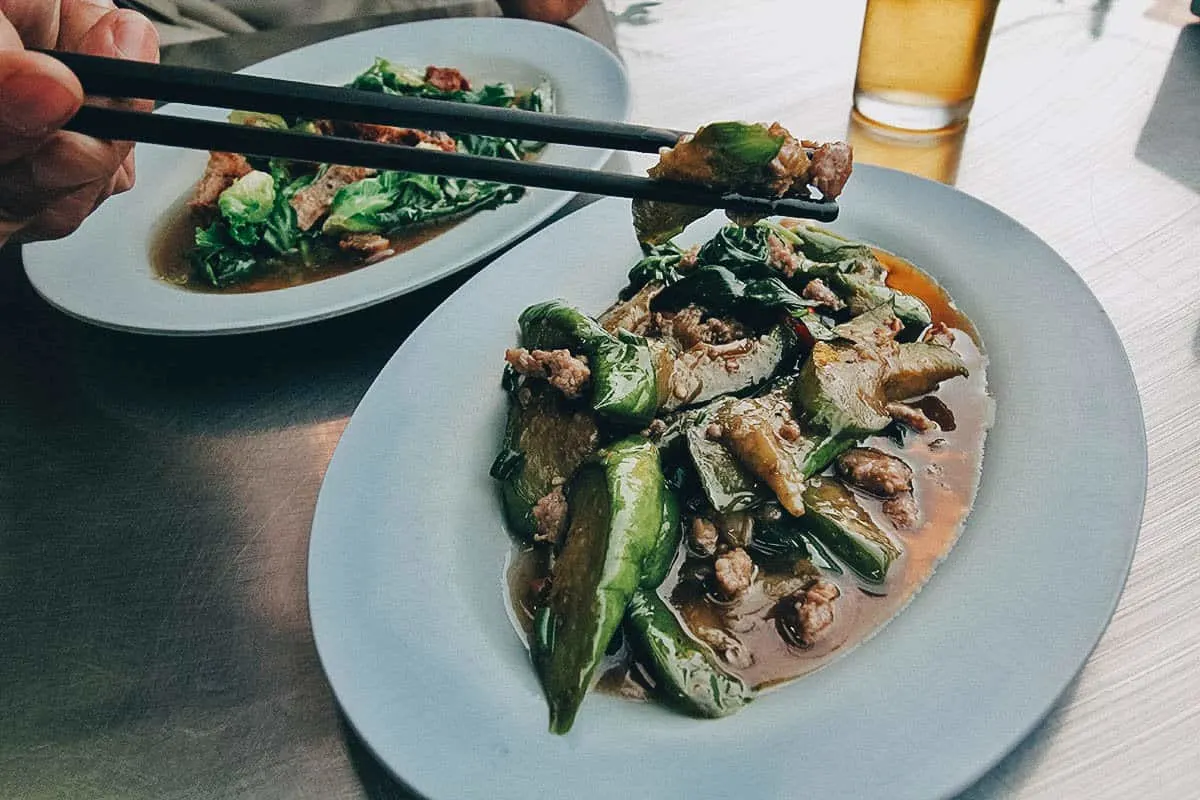
Ja Jaroenchai is a popular restaurant about a block away from the Clock Tower.
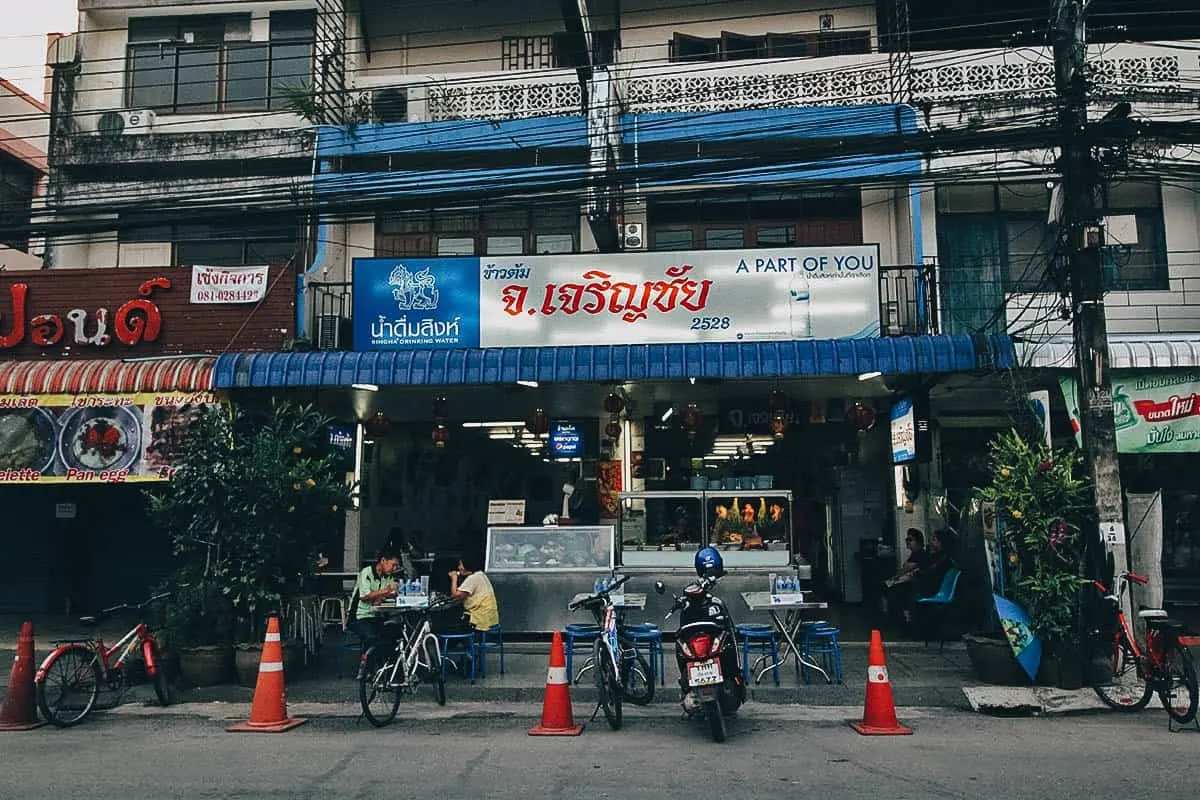
Estimated to Spend: Around THB 60 a plate
5. Chiang Rai Night Bazaar
The food court at the Night Bazaar is a great place to try different types of Thai food, including street food. One of the most popular dishes is hotpot. When you order it, a clay pot over hot coals and containing a soup base is brought to your table along with a basket of vegetables, eggs, and proteins like meat or seafood. Like any Asian hotpot, you’ll cook the food yourself at your table.
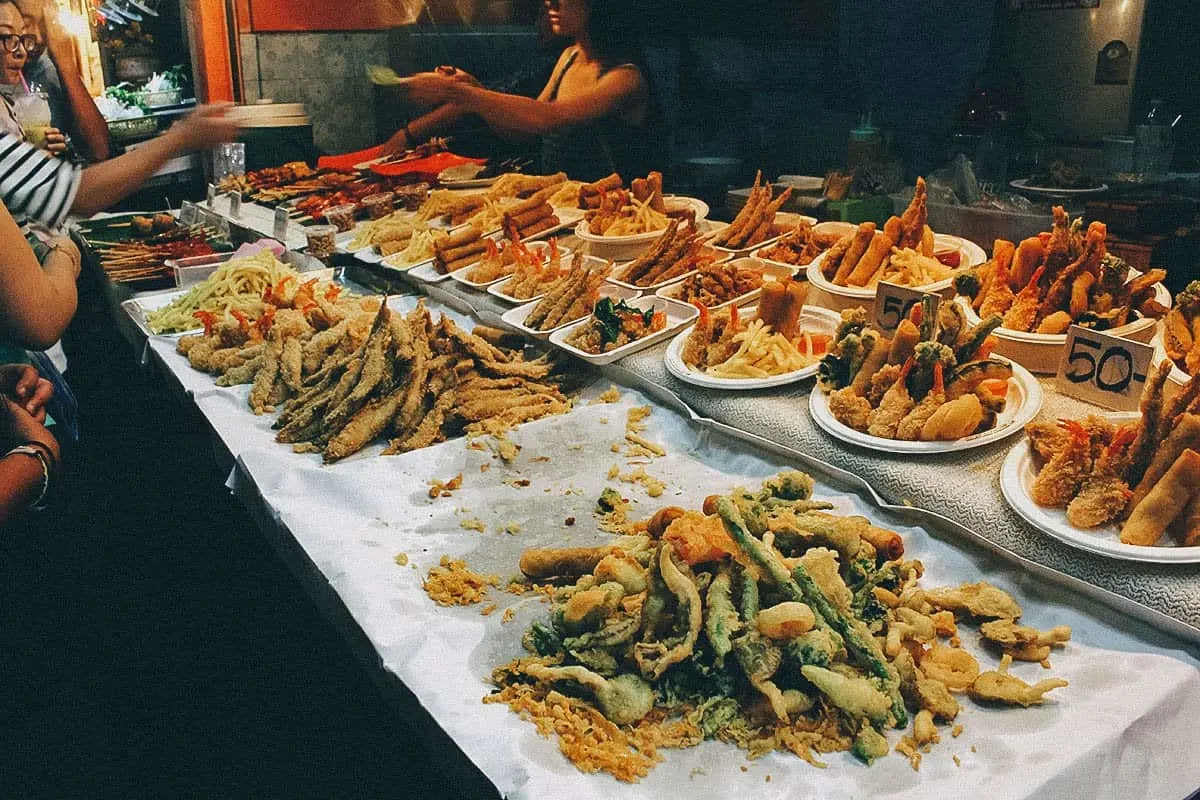
We had already eaten dinner so we were here to drink beer and snack on more exotic fare like deep-fried insects and this goong ten, or “dancing shrimp”. If you’ve never had it before, it’s a ceviche-like Isaan dish of tiny live shrimp “cooked” in lime juice. It isn’t as common to find this dish so I suggest trying it if you see it. It’s delicious. Check out my post on the Night Bazaar for more pictures and information.
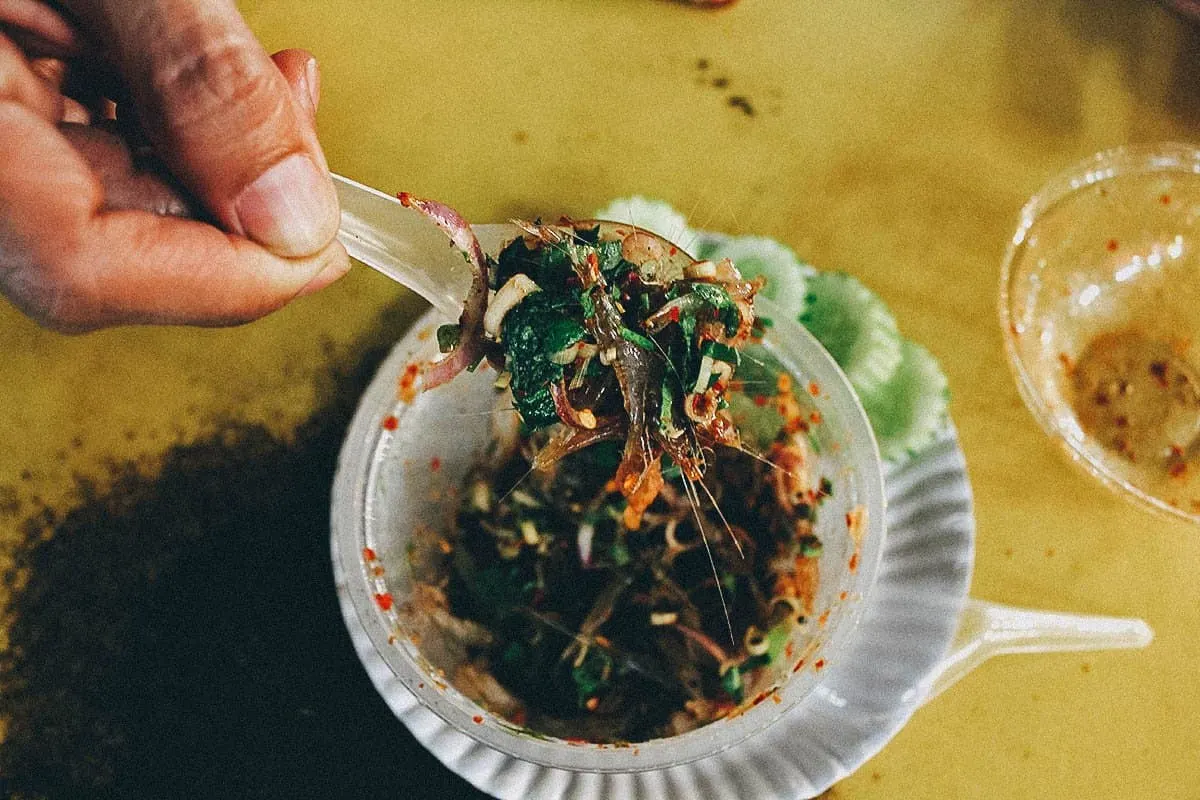
Estimated to Spend: Around THB 50-100 per person
POINTS OF INTEREST IN CHIANG RAI
To help you get your bearings, I’ve created this map so you get a better sense of where everything is. All the places recommended in this guide are pinned on this map.
HOW TO GET AROUND
Chiang Rai is a small city so you can easily explore it on foot. You’ll need to arrange for transportation though to see it’s major attractions like Wat Rong Khun and Baan Dam Museum. We hired a tuk-tuk to take us to both places, wait for us, then drop us off at Lu Lam restaurant for THB 500. If you’re interested in seeing the Blue Temple, then you can ask him to make a quick stop there as it’s en route to the city from Baan Dam Museum.
If you’re interested in dining at Ran Lab Sanam Keela or Lu Lam restaurant, then you can go via tuk-tuk, taxi, or Uber. We used Uber a few times in Chiang Rai. It’s cheap and readily available.
HOW MANY DAYS TO STAY / SAMPLE ITINERARY
As described, Chiang Rai is usually a short stay destination for many travelers. If you’re spending time in Chiang Mai and making a side trip to Chiang Rai, then one full day should be enough. Here’s what you can do with one day in Chiang Rai.
| MORNING • Wat Rong Khun • Baan Dam Museum • Wat Rong Sear Tean |
| AFTERNOON • Lunch at Khao Soi Phor Jai • Clock Tower • Wat Phra Kaew • Wat Phra Sing • Wat Klang Wiang |
| EVENING • Dinner at Ran Lab Sanam Keela • Night Bazaar • Clock Tower Light Show |
TRAVEL TIPS
1. Plan your Trip with Sygic Travel
I’ve been using this free trip planning app for several years now, back when it still used to be called Tripomatic. It’s easy enough to find a city’s top attractions, but how do you organize them all to maximize what limited time you have?
What Sygic Travel does is make it easy for you to see where everything is on a map so you can lump attractions that are in close proximity to one another to create an efficient itinerary. Check out my post on the Sygic Travel app for more information.
Sygic Travel is what I used to create the location map above. You can view it as a day-to-day itinerary as well. Follow this link to check out our 2-day Chiang Rai itinerary on Sygic Travel.
2. Rent a Pocket Wifi Device
Having a stable wifi connection is a must when traveling these days. You’ll need it to post on social media, do last minute research, and learn how to say “where is the best bowl of khao soi” in Thai.
We prefer renting pocket wifi devices when we travel but a sim card will be fine as well. Assuming you’ll be going through Bangkok or Chiang Mai before arriving in Chiang Rai, you can either pick up a 4G sim card at Chiang Mai International Airport, or get a 4G sim card (option 1 | option 2) or rent a pocket wifi device in Bangkok.
3. Check for Discount Passes
There are many online booking platforms that offer travel deals around the world, but when it comes to Asia, my favorite is Klook. Not only is their website the most user-friendly, but they often have the widest selection of activities at the best prices. Follow the link to check out Klook’s list of tours and services in Chiang Rai.
4. Get Travel Insurance
Whether or not to get travel insurance is a personal choice. For me, it depends on where you’re going and what you’ll be doing. If you’re just going to a country like Hong Kong to traveleat for a few days, then you probably won’t need it as much. But if you’re going to Pakistan to free solo like Alex Honnold, then it may be a good idea to pick up a policy.
When we do feel the need for insurance, we get it from SafetyWing. They’re a popular travel insurance provider often used by many long-term travelers. You can follow the link to get a free quote from SafetyWing.
5. Bring the Right Power Adapter
Electrical outlets in Thailand typically feature two-pronged round or flat sockets, either Type A, Type B, Type C, or Type F. Be sure to bring the right power adapters for your devices. Electrical voltage is 220V and the standard frequency is 50Hz.
Have fun!
No way am I an expert on Chiang Rai but I do hope you find this guide useful. I’m only sharing some of the things I learned from our trip. If you have any suggestions or simply want to share your own experiences, then please feel free to do so in the comment section below.
Thanks for stopping by and prepare to be amazed by Wat Rong Khun in Chiang Rai!
Disclosure
Some of the links in this post are affiliate links, meaning we’ll earn a small commission if you make a purchase at no added cost to you. We really appreciate your support as it helps us keep this website going. Thank you!


Amy Trumpeter
Wednesday 12th of September 2018
One of my favourite places in Thailand - I was only supposed to stay in Chiang Rai for 3 days and I ended up staying for a week!
JB & Renée
Thursday 13th of September 2018
Hi Amy, Chiang Rai's got a great vibe. Really laid back. ?
Cappadocia
Sunday 22nd of July 2018
It sound very nice. Love to go one day.